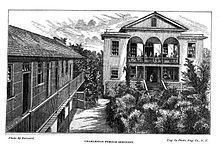Established 1870 | Religious affiliation(s) Christian Founded 1870 | |
 | ||
Founder Henrietta "Etta" Aiken Kelly | ||
The Charleston Female Seminary, also known as Miss Kelly's School, was a private Christian school for wealthy white girls in Charleston, South Carolina.
Contents
History
The school was opened in 1870 by Henrietta "Etta" Aiken Kelly (March 17, 1844 – January 18, 1916) initially in her own home. Kelly, who was an expert on silk worms, had earlier sought to have female students admitted to study at the College of Charleston. After that effort proved unsuccessful, she established the Charleston Female Seminary to offer females access to higher education. Beginning in 1872, the school was housed on 50 Philip Street, in a building constructed in 1871 by architect John Henry Devereux. Devereux used "mixed Roman" Italianate architecture, and "an arcaded and pedimented facade".
Kelly ran the school using the motto Mens sana in corpore sano and incorporated physical education into the curriculum.
In the 1890s, the school occupied the Benjamin Lazarus House on 151 Wentworth Street, at which time a third floor was added to the building. "From 1882 to 1896, the building housed Miss Kelly and boarders of her 'rigorous but genteel' academy". Thereafter, it was at a location that became the Nathaniel Russell House at 51 Meeting Street.
Historical context
The establishment of Female seminaries was a cultural trend across the United States. They were associated with a large and growing trend toward women's equality. Beginning round 1815 and close to the Civil War, it has been said to be at the confluence of various liberation movements.
Southern iterations were "among the most advanced in the country" offering the equivalent of four-year college programs even before the American Civil War. It was part of "an unprecedented social experiment in women's education." Southern female seminaries educated daughters and "education in a renowned and fashionable seminary conferred social capital as well as intellectual and artistic satisfaction". The continuing changes at Charleston Female Seminary aligned with trends throughout the United States. They included ever growing facilities in a more institutional format. Classical building structures became a norm, and were in sharp contrast to earlier forms of female education which moved from boarding schools and private education to seminaries. By midcentury, "female seminaries and academies were everywhere, replacing the homelike atmosphere of boarding schools with a more institutional setting". These larger buildings housed "dormitory rooms, chapels, dining halls, and classrooms". The timing of the opening of a female seminary in 1870 was significant, as there was a retrenchment in female education following the Civil War.
Another Charleston female seminary was Miss Murthen's Seminary for Young Ladies.
Distinguished alumnae
A notable alumna was author Beatrice Witte Ravenel (August 24, 1870 – March 15, 1956), mother of the South Carolina architectural historiographer Beatrice St. Julien Ravenel (October 3, 1904 – December 2, 1990).
Another was Hermine Kean Bulwinkle (1868–1942), who married Solomon Anderson Wolff (1861–1954) in 1890. Both were on the faculty Gaston College, Dallas, N.C.
A third notable alumna was Sarah Campbell Allan (1861–1954), who went on to become a physician in spite of educational and professional barriers she encountered as a woman. After completing a medical preparatory course at the South Carolina College for Women in Columbia and studying medicine at the Women's Medical College of the New York Infirmary for Women and Children, in 1894 she was licensed as a physician by the state of South Carolina. She was the only woman in the pool of applicants examined by the South Carolina Medical Board that year, the first time the board sat to examine applicants, and she received the board's highest grade. As a doctor, for 11 years Allan worked with female patients at the South Carolina Hospital for the Insane in Columbia and taught anatomy and physiology to nursing students.
Sarah Visanska graduated from the Charleston Female Seminary in 1889. She was president of the South Carolina Federation of Women's Clubs from 1910-1912.
